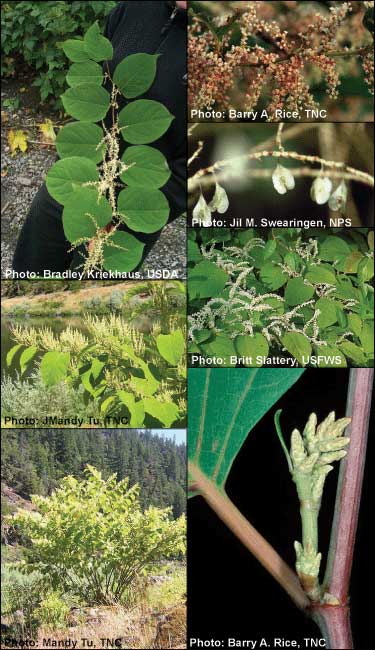Japanese knotweed (Fallopia japonica)
 Synonyms: Polygonum cuspidatum
Synonyms: Polygonum cuspidatumCommon Names: Mexican bamboo, Fleeceflower, Japanese bamboo
Description: This species is prohibited under Michigan law; forms dense thickets that shade out natives; rhizomes can damage pavement; extremely difficult to eradicate; spread by flood waters.
Habit: Perennial, herbaceous shrub reaching 3 m (10 ft); larger than many woody shrubs; stems die but stalks persist through winter.
Leaves: Simple, alternate, broad, up to 15 cm (6 in) long and 12 cm (5 in) wide with an abruptly pointed tip and a flat base.
Stems: Upright; round; hollow; glaucous; often mottled; nodes with a papery membrane; persistent; dead stalks resemble bamboo.
Flowers: Numerous, small, green-white in color, borne on a slender stalk in leaf axils near the ends of stems; bloom August through September.
Fruit and seeds: Fruits are three-winged, 8-9 mm, seeds are dark and glossy, wind and water dispersed.
Habitat: Semi-shade tolerant; found along roadsides, stream and river banks, wetlands, wet depressions and woodland edges; can tolerate a wide array of soil and moisture conditions.
Reproduction: Primarily through rhizomes or fragments; some U.S. populations produce abundant fertile seed; forms fertile hybrids with giant knotweed (F. sachalinense); germination rates vary between populations and with timing of seed harvest.
Similar species: Non-native giant knotweed (Fallopia sachalinensis) has much larger leaves (> 6 in long) with rounded, heart-shaped bases.
Monitoring and rapid response: Monitor riverbanks, stream and pond edges, particularly downstream from known occurrences. This species is difficult to control - research control options thoroughly. On riparian sites, consider upstream and downstream populations and herbicide impacts. Multiple control strategies may be needed for a single population. Resprouts vigorously after cutting, mowing, tilling and digging. Tiny fragments of roots and stem nodes can sprout and form new colonies, remove all cut plant materials and incinerate or place in landfill. Foliar herbicide application may provide effective control. Cutting or spraying early in the season and then spraying later may be easiest as plants will still be short enough to spray efficiently. Wicking or injecting herbicide may be suitable for ecologically sensitive sites but is labor intensive. Follow-up required for years. Credits: The Michigan Natural Features Inventory (MNFI) has partnered with MISIN to provide the information in this fact sheet. Species images and/or information were used with permission from "A Field Identification Guide to Invasive Plants in Michigan's Natural Communities" and "A Field Guide to Invasive Plants of Aquatic and Wetland Habitats for Michigan.
Common Name: | Japanese knotweed |
Scientific Name: | Fallopia japonica |
Family: | Polygonaceae (Buckwheat) |
Duration: | Perennial |
Habit: | Herbs |
USDA Symbol: | FAJA2 |
 View Species Course |
|
